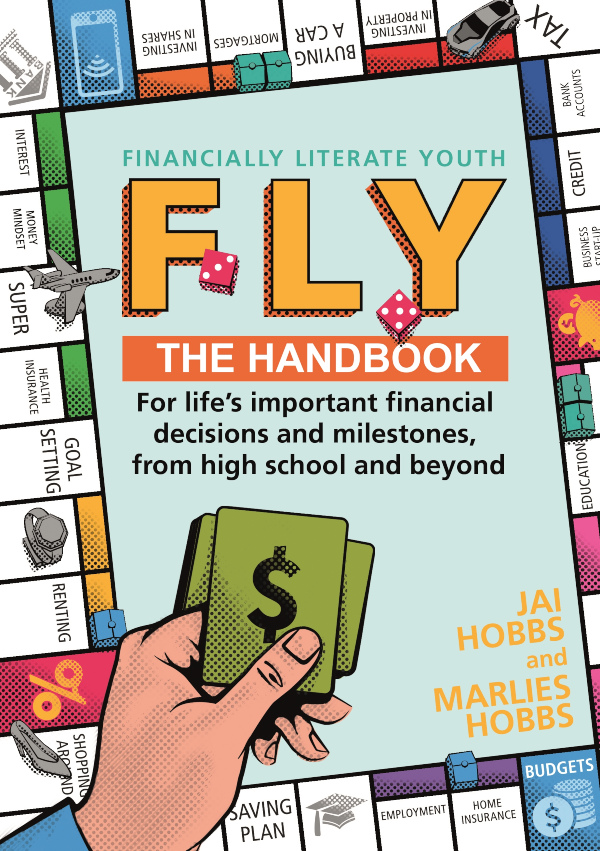Given the tawdry state of my finances, there’s a line by the writer Katie Whitehorn that I’ve always found endlessly comforting. “The easiest way for your children to learn about money is for you not to have any,” she writes.
That was certainly the personal experience of mortgage broker, Jai Hobbs.“I grew up in Cairns in a broken household,” he admits. “My parents did the best they could, but money was definitely not something that we had in abundance when I was a child.”
Consequently, Jai left school “knowing nothing about money”. But after stumbling into a finance job when he was 20 years old, things quickly developed from there. Today, Jai and his wife, Marlies, have built more than 10 properties and launched a range of businesses including a mortgage brokerage, several cafes and a franchise company. To pass on some of their business-savvy tips, the pair have now written FLY: Financially Literate Youth, a book that’s designed to empower young people to successfully navigate their financial decisions.
“Money is definitely not what life’s about,” Jai insists. “But it gives us a hell of a lot of peace of mind and allows us to enjoy life if we can just put some simple habits in place so we don’t have to worry about it so much.”
Here, Jai share his five money principles that he believes that every dad should teach his young kids.

The purpose of money
Jai has two sons aged six and nine. Rather than shield them from financial dealings, he actively tries to involve them in the process. After a family breakfast at a café, for example, he’ll take his kids to the counter when he pays the bill. “You want your kids to understand that money is a function of life.”
He recommends trying to demystify the financial world by constantly explaining the underlying purpose of money. “You want them to understand that money does need to be earned and it’s the way that we exchange products and services,” he says.
“Explain that it’s not the money itself that we want, it’s what money can get us and what we can exchange that for, whether that be freedom, peace of mind, opportunities or greater choice.”
The format of money
You access your money in different forms whether you’re paying with cash, a savings card or your credit card. “Explain all the different ways of paying, rather than allow your kids to thinking that money just comes out of dad’s wallet or from some endless supply from the hole in the wall.”
If you’re paying for something on your credit card, for example, point out that this isn’t free money but something that will ultimately need to be repaid.
“In today’s world of never-ending credit, we need to get our children to understand at an early age that although credit can be good and leverage can be fantastic, you’ve always got to be cautious about it,” Jai says.
The value of money
“Help your kids to understand what things cost,” Jai says. If you’re standing at the counter paying for that family breakfast, share the fact that it’s $85 and make it more tangible by relating it back to their pocket money. “When our kids realise that breakfast is the same as eight weeks of their pocket money, their jaws hit the floor,” he says.
Showing your child the value of money from a young age will help them to appreciate it more fully and (hopefully) treat it with the consideration it deserves.
“We found this to be good with our kids,” Jai says. “It’s not about harping on about money all the time. It’s just getting them exposed to it as early as possible.”
How to earn money
Just because you’re being transparent about the cost of living doesn’t mean limiting your children’s dreams. “Our nine-year-old wants a motorbike at the moment,” Jai says. “So I said, ‘Yeah, that’s fine mate, but motorbikes are $2000. How are we going to do this?’
“I’ve said to him. ‘If you want that motorbike, well, you’ll have to sell your quad bike, and then, whatever the difference is, you come up with half and I’ll put it in the other half.’ Immediately now my son has been relating that to: ‘How do I make extra money? Can I do extra jobs to earn it? Can I go and steal the neighbor’s lemons and sell them back to them?’”
By breaking down the mechanics of the transaction, Jai’s son has quickly sussed out that he can reach his goal a lot quicker by doing extra jobs to supplement his weekly pocket money. “So from a young age, we’re getting them to think about how can they add value and increase their earnings rather than just waiting for the pocket money?”
How to save money
“Every financial expert has always said the golden rule is spend less than you earn. So the earlier we can get our kids doing that, the better. How we do that with our boys is to instil the message of spend 50%, save 50%.”
Jai admits his sons respond differently to this encouragement. His six-year-old is already a disciplined saver while the nine-year-old will happily “live on credit if he wants something”.
But the main point is simply to familiarise your kids with the concepts of saving, credit and debt, Jai explains. “When we’re out, if the boys want a toy or something, we’ll say, ‘Yeah, no worries, you can have it – but you have to pay for it yourselves.’ More often than not, that changes their mindset straight away.”
FLY: Financially Literate Youth is out now